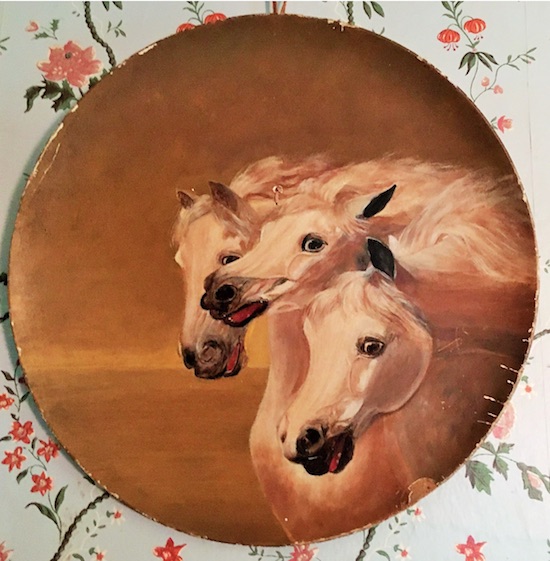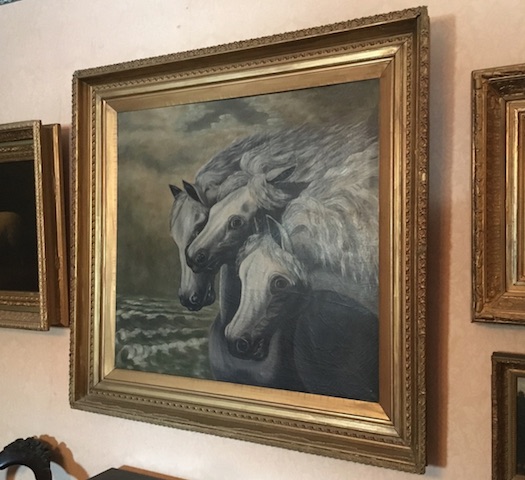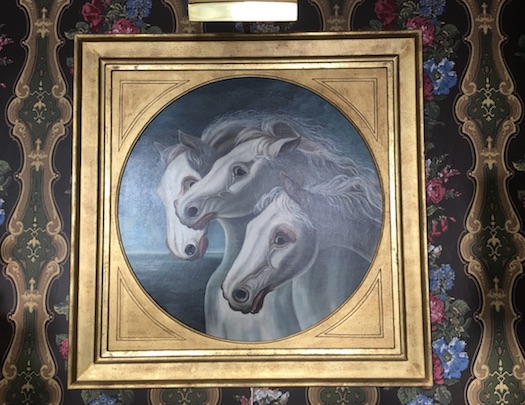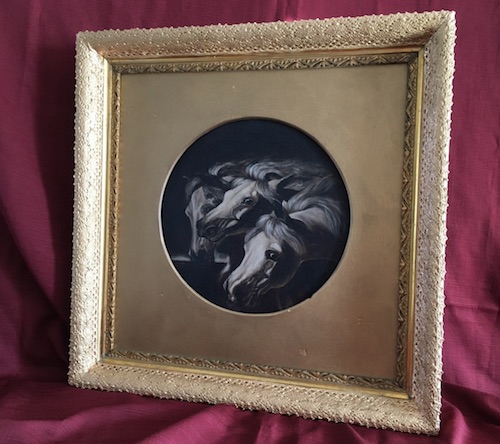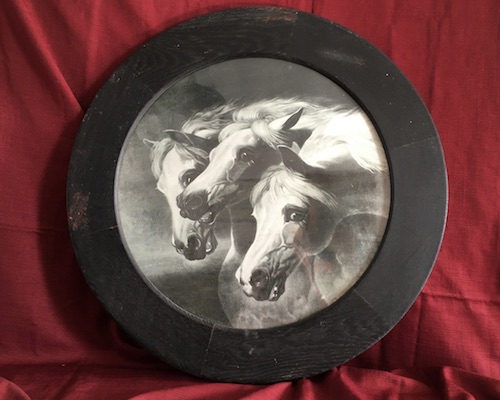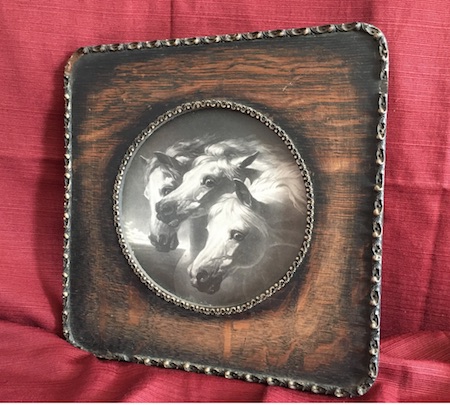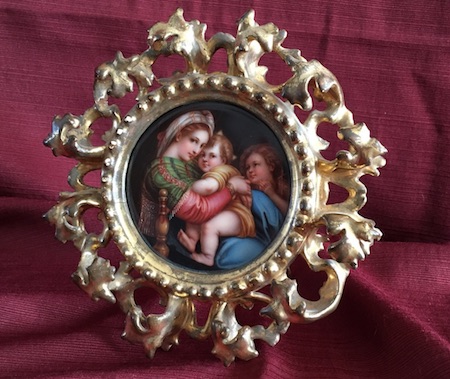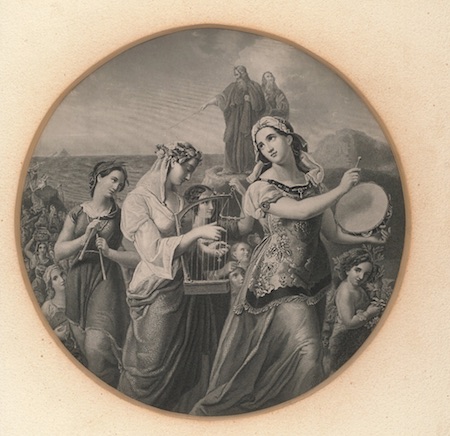Historic Childs: Popular Images of Yesteryear, Part 3 – ‘Pharaoh’s Horses’
By Bill Lattin and Doug Farley – Vol. 3 No. 2
GAINES – For our third famous painting from the 19th century we have selected what is known as “Pharaoh’s Horses,” or “Pharaoh’s Chariot Horses.” The painting seen here has hung in the Cobblestone Museum’s Ward House for over 30 years.
It was done, no doubt, by an amateur painter around 1890. We might add that it was poorly executed as the lower left area is supposed to represent “a wall of water.” We also note that this painter chose to use a monochromatic color scheme of yellow ocher.
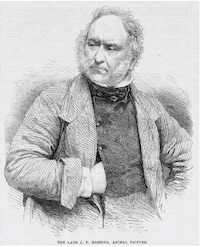
John Frederick Herring, Sr. (1795-1865)
By 1900, this popular image was widely viewed with nearly ubiquitous fake paintings and prints. It is also most usually seen as a “tondo,” meaning in round format.
Many of our readers might be a little more familiar with this image, rather than the images shown in Parts 1 and 2 of this series. However, in today’s world, it is mostly forgotten and its meaning is often not understood.
The original “Pharaoh’s Chariot Horses” was painted in 1848 by John Frederick Herring, Sr. He was born in London, while growing up, he took great interest in drawing horses. In 1814, he moved to Doncaster in the north of England where he was employed as a painter of inn signs and insignias on the sides of coaches.
In his spare time, he painted portraits of horses for inn parlors. His talent was soon recognized by wealthy customers and he began painting hunters and racehorses for the local gentry. In 1845, Herring received a commission from Queen Victoria, who remained a patron for the rest of Herring’s life.
In order to get a better understanding of this painting we need to go to the biblical Book of Exodus to find answers contained in the description of the Ten Plagues of Egypt.
The Lord said to Moses, “Why are you crying out for help?” Tell the people to move forward. Lift up your walking stick and hold it out over the sea. The water will divide, and the Israelites will be able to walk through the sea on dry ground. (Ex. 14:15-16)
This large painting measuring 32 x 34 inches is an oil on canvas in tones of grey. It would have been done by a Sunday Painter in the 1880s. Unlike most copies it is rectangular in format. Note the waves of water in the lower left corner. The painting hangs in the home of Bill Lattin.
…and the Israelites went through the sea on dry ground, with walls of water on both sides. The Egyptians pursued them and went after them into the sea with all their horses, chariots, and drivers. (Ex.14: 22-23)
The oil on canvas shown here measuring 24 inches in diameter was done around 1890 by Harriet Wyman Kilner from the Town of Shelby. She was a Sunday Painter who often copied other artists works. Known as “Aunt Hattie,” she was an older sister to Bill Lattin’s Grandmother Wilson. This painting is now currently owned by local art connoisseurs. We note that it was largely done in tones of blue.
The Lord said to Moses, ‘Hold out your hand over the sea, and the water will come back over the Egyptians and their chariots and drivers.’ (Ex. 14:26)
Here we have another oil on canvas by a Sunday Painter dating to the 1880s. It measures 12 inches in diameter and belongs to a local collector. This piece was done largely in tones of brown.
The water returned and covered the chariots, the drivers, and all the Egyptian army that had followed the Israelites into the sea; not one of them was left. But the Israelites walked through the sea on dry ground, with walls of water on both sides. (Ex 14:28-29)
We judge this print measuring 20 inches in diameter was published around 1900, and appears to be in its original frame.
In all of the images we see, it is obvious that the horses saw what was coming at them as there is great fright in their eyes. Moses parting the Red Sea and the Children of Israel “passing over” onto dry ground, is still celebrated by Jewish people today, as part of their observance of Passover.
This small print measuring 6½ inches in diameter was published in the 1890s and is mounted in its original frame.
The popularity of this picture was widely accepted, especially by Protestants, who were often reluctant to have other overtly religious pictures in their homes, mainly because of anti-Catholic sentiment.
Therefore, “Pharaoh’s Horses” was much more acceptable and popular in rural 19th century America than any of Raphael’s beautiful paintings of the Madonna and child. Above we see a copy of Raphael’s famous “Madonna of the Chair,” done on porcelain, circa 1890.
This 3½ inch diameter painting in a Florentine frame belongs to a local collector. It was probably originally purchased by an American tourist on a trip to Italy. Raphael did a number of Madonna portraits in the early 16th century. In this one, Mary is seated in a chair holding baby Jesus while John the Baptist looks on. Now in the 21st century, there is more public recognition of this than the once very poplar Pharaoh’s Horses in the 19th century.
We end this story with an illustration which shows a conclusion to Pharaoh’s Horses and the Parting of the Red Sea.
The prophet Miriam, Aaron’s sister, took her tambourine, and all the women followed her, playing tambourines and dancing. Miriam sang for them: “Sing to the Lord, because he has won a glorious victory; he has thrown the horses and their riders into the sea.” (Exodus 15: 20, 21)
In this rare engraving we see in the foreground, Miriam with tambourine leading the women in joyful triumph. In the middle ground we observe Moses with walking stick, and Aaron, both standing on a cliff. In the background note the sea and pyramids in the far distance. This Victorian print measuring 9” in diameter dates to around 1880 and is in a local private collection.






























